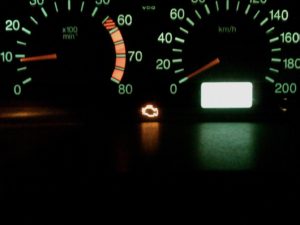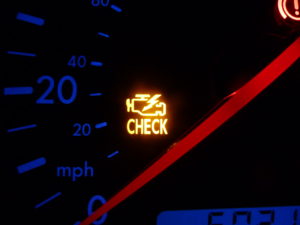It’s happened to all of us. We’re driving down the road when all of a sudden, that little orange or yellow light pops on that says “Check Engine.” You have a moment of panic, thinking ‘Why is my check engine light on?’ and hurry to the destination hoping that the car won’t break down on the way. Whether the engine isn’t getting enough air, or there is a serious issue at hand, the immediate focus becomes getting the problem fixed and the light turned off. Here are the most common reasons why your ‘check engine’ light is coming on, and what needs to be done to fix the problem.
- The Mass airflow sensor (MAF) has a faulty sensor and is reporting an inaccurate amount of air being pulled into the engine.
- This causes the engine to add an incorrect amount of fuel and can cause reduced gas mileage or stalling. Luckily, the problem is easy to detect and easy fix for your mechanic.
- This puts extra pressure on the engine, forcing it to work harder for fewer
- Over time, a faulty MAF can cause damage to the ignition coils or O2 sensors, and clog the catalytic convertor.
- You can do a light test to check the ignition coil by inserting one contact pin of the test light into the high-voltage line jack. Then, use the other contact pin to scratch the low-voltage terminal and watch carefully. The component is working well if the test light doesn’t remain on and there is a small spark on the low-voltage terminals. If there is no spark, it’s time to buy new ignition coils for car as it’s a sign that you have at least one failing ignition coil.
- Often, the problem lies in the air filter not being replaced or being improperly installed. Check this first before replacing the MAF, you can save money in the long run by regularly changing the air filter. A replacement will typically cost between $200-300.
- It’s time to change your spark plugs.
- Or perhaps just the wires. Either way, without a proper spark, the oil/air mixture in the engine isn’t performing optimally and can clog the catalytic convertor. You will notice reduced performance by the engine and slower accelerating, and the car will burn through gas at a much higher rate.
- The wires deliver the spark from the ignition coil to the plugs. If the plugs are worn out, the spark will misfire. If this process is not happening correctly, it can cause severe damage to the engine over time.
- On vehicles made before 1996, spark plugs should be changed out after 25,000 miles, on newer vehicles they can often last up to 100,000 miles. They are usually accessible right under the hood of the car, and videos on YouTube can show you how to change them yourself.
- The catalytic convertor needs changing.
- Speaking of this important part, your car will emit higher emissions as the carbon monoxide isn’t properly converted to carbon dioxide, which can also cause the vehicle to run at higher temperatures and put extra wear on the engine. Both this and problems with the spark plugs/wires can be easily noticed and the parts replaced by a mechanic.
- The vehicle will likely fail an emissions test if there is a problem with the catalytic convertor. When it is clogged, the car is emitting dirtier fumes at a much higher rate.
- Replacing the catalytic convertor can cost nearly $2,000. This is a big reason to keep up on other engine-related maintenance, spending a little now can save you big down the line.
- You will notice severely decreased acceleration when the catalytic convertor is failing. It shouldn’t fail if other engine maintenance is maintained, most problems with this part are a result of other issues not being taken care of promptly.
- You’ve either lost or incorrectly secured the gas cap.
- Whoops! Not only will your car be emitting hydrocarbons when not in use due to the lack of a seal on the tank, the tank will lose pressure and the gas won’t perform well. The engine’s computer will pick up on this over time, which is what turns the light on. This is a simple fix – just go to an auto parts store or dealership and buy a new gas cap.
- If you don’t notice anything weird about how the car is driving when the check engine light comes on, check the gas cap first. You may just need to tighten it.
- Change the oil!
- As simple as it sounds, many people do a terrible job of keeping up on oil changes. There is no dumber way to ruin your car’s lifespan and performance than by not following recommendations on oil changes. They are cheap, quick, and with a little learning, the effort can be done at home in your garage.
- Use the correct type of oil (i.e. 10w30, 5w30, etc.). The magnet sticker on the inside of your windshield from the previous oil change will often note which kind to use, or check the car’s manual.
- The O2 sensor is worn out and needs replacing.
- The oxygen sensor calculates the amount of air in a vehicle’s exhaust system, and if it isn’t working correctly the engine won’t perform as well as it should and you’ll burn through fuel much faster.
- Worn out sensors can damage other engine parts such as spark plugs and the catalytic convertor.
- If the sensor isn’t replaced, your fuel economy will continue getting worse, until you are losing up to 40%.
- Most cars have 2-4 O2 sensors. Using an obd2 scanner will tell you which one needs replacing. Your car’s manual should detail how to change them, and all you need to do is unclip the old one and clip on the new one.
Conclusion
Why is my check engine light on? Now you have the six most common reasons why this happens and what to do about it. The key to minimizing the light’s impact is to address the issue promptly instead of driving on it for days or weeks. Check the gas cap, head inside and ask a clerk to run a scan on your 6.0 powerstroke engine to determine the issue. Often, it can be fixed quickly and cheaply without causing too much stress. Because the light doesn’t tell you what the issue is, I suggest pulling into the nearest auto parts store if you’re not sure what could be wrong. If on the other hand you suspect or know that the issue does in fact pertain to the engine itself, you may want to head straight to a machine shop so the experts can get to work on it.
Author Bio:
My name is Tim Miller from Denver, Colorado.
I don’t know why I do love cars and always want to discover them.
At present, I’m I am a 10 years experienced mechanic and writing a blog named: http://www.obdadvisor.com/ to share my knowledge and experiences to everyone.









